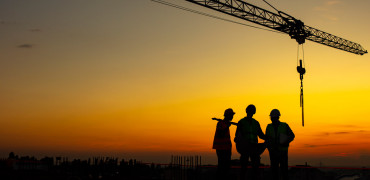I recently spoke at the Flexable Space Association Annual Conference which was focused on environmental sustainability and wellbeing as areas of growing interest to workspace operators.
The Flexible Space Association (FLEXSA) is the professional trade body for the flexible workspace industry – a sector that has grown over the past decade and which has really come to prominence in the past few months as businesses assess what they need from the office of the future.
Many companies are now questioning whether they need that large central HQ, or whether they can use more localised ‘hubs’ for staff, using the services of companies like the members of FLEXSA.
The topics of wellbeing and environmental sustainability were chosen for the conference as they are areas of growing interest to workspace operators, who are in turn receiving an increased number of enquiries from prospective and current clients on what they do in these areas.
My brief presentation to the conference focused on the road to net zero and I took delegates through the legislation that is driving change and ensuring that everyone plays their part on our journey to net zero carbon emissions.
The good news is that energy efficient, effective solutions are already available
The imperative to change
And there’s a reason that the legislation is getting tougher as there is a real and urgent need for things to change.
The simple, undeniable fact is that the world is getting warmer, and the science tells us this is down to us, our choices, our activity over a relatively short period of time in global terms
There’s an image that shows the global average temperatures from 1850 on the left to 2018 on the right – created by Professor Ed Hawkins at the University of Reading.
It starkly demonstrates the dilemma we face and highlights the undeniable truth – We have to do something!
What is Net Zero?
We’ve all heard the phrase ‘Net Zero’ but it isn’t often explained and many assume that everyone understands what it actually means, and the steps we all need to take to get there.
As this journey involves everyone, I think it important that everyone understands fully what is being asked of them, so I took the conference through the graphic from the Climate Change Committee within their report ‘Net Zero – The UK’s Contribution to Stopping Global Warming’.
Net Zero can be defined as the balance between emissions generated and emissions absorbed.
Obviously not driving down emissions generated, will mean absorption has to take on a far higher burden to achieve the goal, and the technologies do not exist at the scale needed to achieve this.
Emissions today come from many varying sources, with the emissions generated in buildings around 30 to 40% of the total.
That’s why many of the regulations and legal drivers are demanding that buildings and their operators use less energy and factor in the carbon footprint of both their operations and the materials and products used within those buildings.
The WELL Standard
Buildings are becoming more operationally efficient, but given that we spend so much of our time indoors (with some statistics having this as high as 90% when including vehicles into that number), then these spaces also need to be seen in regard to other criteria.
This is probably best captured by the internationally accepted WELL standard, which looks 10 different elements covering: Air, Water, Nourishment, Light, Movement, Thermal Comfort, Sound, Materials, Mind, Community.
Whilst Thermal Comfort has always been seen as crucial in the world of HVAC, if we look a little deeper at Air for example, this has been brought into stark relief during the pandemic.
What it now means for anyone designing or operating a building is that we must ensure that buildings have adequate clean amounts of air to dilute internal spaces.
Ventilation, Filtration & IAQ
There are moves to clean the outdoor air in our towns and cities, but regardless of the state of the air outside our buildings, they should be able to act as a ‘safe haven’ for occupants.
The introduction of clean, fresh air into internal spaces should also be accompanies by the extraction of indoor pollutants, bacteria and viruses – both of these are critical for occupant wellbeing and reassurance and Building Regulations are being revised in line with this to ensure higher ventilation rates/p/m2 of floor area.
The flipside of this is that higher ventilation can mean greater energy use so we need to find ways of counteracting this energy increase, and this is where monitoring the indoor air quality (IAQ) is going to be a vital element of health and wellbeing in the future workplace.
Effective solutions are available
Another thing to note is that the term ‘fresh air’ is now seen as dated – which is something I personally am finding hard to stop referring to having done so my whole career.
Now, we should be talking in terms of clean air and by this, we mean the right volumes of air applied to internal spaces that is the right temperature, the right moisture content but importantly clean.
The good news is that effective solutions are already available in the form of energy efficient mechanical ventilation with heat recovery (MVHR)
There are also filters that can remove pollutants, irritants and viruses from the indoor air and ventilation systems that will work with CO2 sensors to vent spaces that have seen a build-up of stale air.
Shifting Work Patterns
According to the Office of National Statistics, working from home was already on the rise pre pandemic, and since 2020, it seems to be stable at around 37% of the workforce.
Obviously, there are many factors affecting people’s work preferences and businesses are looking to use increased remote working in the future
A study by Strathclyde University, in a poll of 3,000 participants, showed that 78% of the workers interviewed want to come into the office for 2 or less days per week.
So, we now have a mixed approach with flexibility and choice for both the businesses and the employees.
One thing is clear in my opinion though – The office is here to stay. I don’t believe we will see a full return to 9-5, five days a week for the overwhelming majority of businesses, so a hybrid approach will best “meet employees needs” and allow us all to operate effective and profitable businesses.
However, the office of the future will look and operate differently, with much more focus on both energy use and wellbeing and comfort for occupants.
Change of use
We are also likely to see a change of building use with recent studies showing that:
- 45% of businesses with office space plan to downsize by an average of 40% - changing areas to retail etc.
- 18% of businesses have already made these changes
- Most other plan to do so over the next few years leading to 2025
Occupiers are now looking for “amenity-rich” spaces that support an enhanced working space. It’s also a time of high employment, so both existing and prospective employees can afford to be choosy.
Businesses looking to keep their most valuable asset – the workforce – productive and engaged need to look at the office they offer their staff.
The future office will not only need to offer flexibility, with a combination of open plan desk areas and collaborative meeting spaces, it will need to be able to offer the latest communications technology such as video conferencing, decent wifi, network etc.
It will also have to be able to accommodate vastly differing changes in the levels of occupancy, with Mondays and Fridays likely to be much quieter than the rest of the week.
Building services such as HVAC equipment will have a critical role as they are key to delivering energy efficient cooling, heating, ventilation and filtration to a wide range of building types, and these services will be critical to both energy efficiency and wellbeing.
We have prepared a white paper on the future of offices, which is free to download here.
Time for action
The audience at FlexSA were completely onboard with the general theme of the conference and were eager to learn more, which is an important lesson for all of us.
No one person, company or government can fix things on their own. We are all in this together as there is no Planet B.
Can we fix climate change? No, but we can reverse the worst of it … and we must.
What we have to collectively do is ask ourselves what can we do about it and how quickly?
We have the power to decarbonise the UK built environment together.
Now is the time for us all to act.
Martin Fahey is Head of Sustainability




